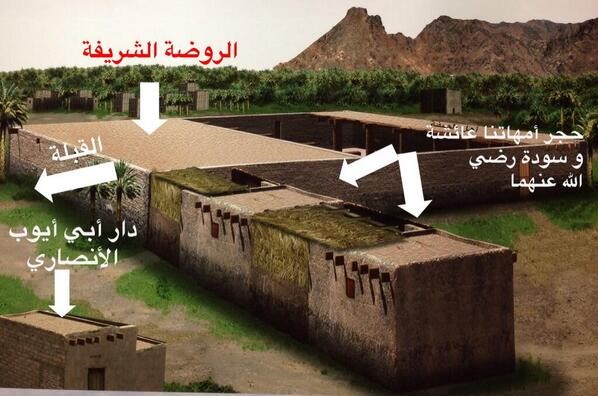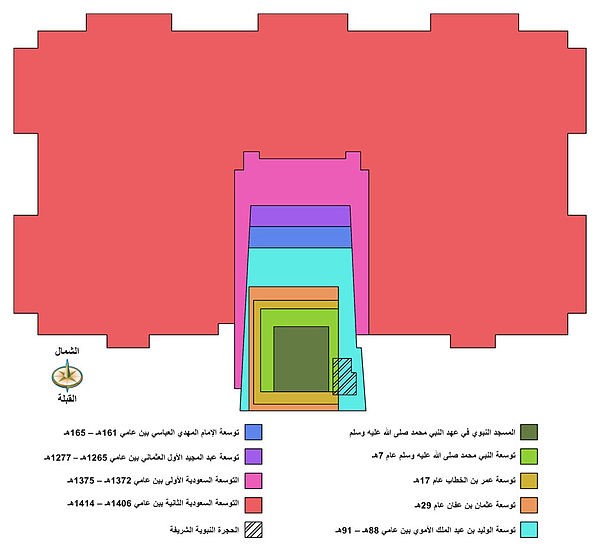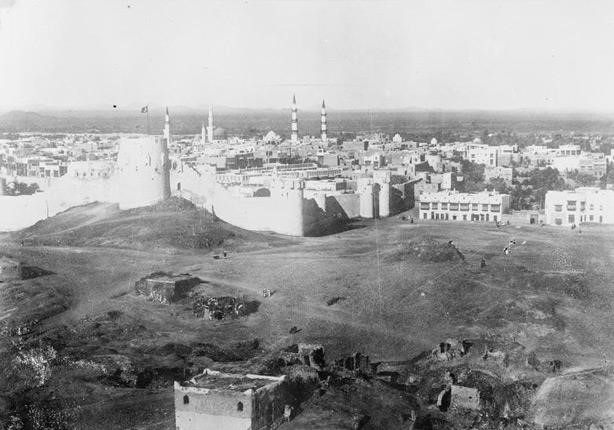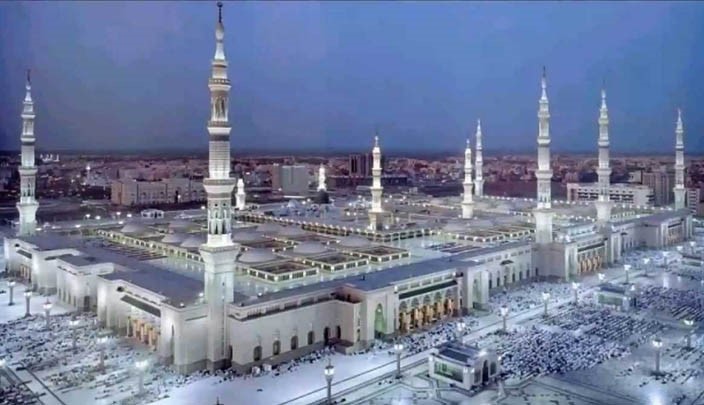Al-Masjid an-Nabawi One of the most important tourist attractions in Medina is one of the largest mosques in the world and the second holiest site for Muslims after the Grand Mosque. It is the mosque that the Prophet built in Medina one year after the Hijrah, which is equivalent to 622 next to his house after the construction of the Quba Mosque. The mosque witnessed many expansions throughout history, which passed during the era of the adult caliphs, the Umayyad state, the Abbasid and Ottoman empires, and finally, in the era of the Saudi state, after the expansion of Omar bin Abdul Aziz in the year 91 AH, in which the Prophet Muhammad, Abu Bakr and Omar bin Al-Khattab were buried in Aisha’s room (Now known as the "Chamber of the Holy Prophet", located in the southeast corner of the mosque), the green dome is one of the most striking features. Prophet's Mosque. The mosque played an important role in political and social life. It served as a social center, court, and religious school. The mosque is located in the center of Medina and is surrounded by many hotels and old markets nearby. Many people who perform Hajj or Umrah visit him and visit the tomb of the Prophet Muhammad to bring him peace.
Content
The Prophet's Mosque in the era of the Prophet
Al-Masjid an-Nabawi in the era of Omar Ibn Al-Khattab
The Prophet's Mosque in the era of Othman bin Affan
The Prophet's Mosque during the Abbasid era
The Prophet's Mosque in the era of the Prophet
The Prophet's Mosque in the era of the Prophet

The first Muslims of the Ansar gather in front of the Prophet’s migration and pray at a place in the center of Medina al mnwarah (its name is Yathrib), where Musab bin Umair (Messenger of the Prophet Muhammad in Mecca) prayed and taught them the Holy Qur’an. He has a swamp (camel stall and detention) for two orphans, Sahel, Ibn Amr, and I was on the stone of Asaad Ibn Zurara in the Prophet's migration, when the Prophet Muhammad came to Medina, blessed his elegance in the place where the Ansar prayed. He said: “This house is ready for God.” And they said: “But it was looted for you, Messenger of God.” Abu Bakr. The Prophet Muhammad built the mosque in Rabi’ al-Awwal in the month of 1 AH, which is equivalent to 622, and it was about 35 meters long, 30 meters wide, and 1050 square meters in area, and its ceiling was about 2.5 meters high. The pillars of the mosque consist of palm tree trunks, its treetop (palm branches), its stone foundations, and the brick wall (raw bricks that were not burned by fire), and they made the center of the mosque wide (square). The Prophet Muhammad built with them and carried stones and milk. The mosque has three gates: Bab al-Rahma, which is called Bab Atka (on the western side) and Bab Othman, which is now called Bab Jibril, from where the Prophet Muhammad entered (in the east), and a door in the back (in the south) and the qiblah of the mosque is made to Jerusalem, And when the qiblah entered the Kaaba in the year 2 AH, the door that was at the back and a door opened on the north side. He also built two houses for his wives, Aisha
Al-Masjid an-Nabawi in the era of Omar Ibn Al-Khattab

17 AH, Caliph Omar Ibn Al-Khattab expanded the Prophet's Mosque due to the large number of Muslims as a result of the Islamic conquests and the expansion of the Islamic state. It was the first expansion of the Prophet's Mosque since its construction and expansion during the era of the Prophet Muhammad. Abu Bakr reported the events that resulted from the death of the Prophet, but he renewed the dead palm columns. When Omar assumed the caliphate, he said, “I want to increase the mosque, and if I had not heard the Messenger of God, peace be upon him, say: “The mosque should be increased,” I would not increase anything.” Omar began buying houses around the mosque for expansion, except for the rooms of the mothers of the believers, and a house for Abbas Bin Abdul Muttalib on the Qibla side of the mosque. Abbas grew up in it, and Omar began to expand it, and to build the foundation of the mosque with stones until it reached about two meters, so that it rose from the side of the qiblah to the middle passage between the prayers of the Prophet. The Ottoman church, about 5 meters, rose by 15 meters on the north side and 10 meters on the west side, and raised nothing on the east side. The length of the mosque from north to south is 70 meters, its width is 60 meters, and its ceiling height is about 5.5 meters. He made six gates for it: the three old gates, the “Peace Gate” that opened on the first western wall, the “Female Gate” on the eastern wall and a gate on the northern face. He asked for measles (small stones) that came from agate and divided them into the mosque. The extension of Omar required the incorporation of Abu Bakr's house into the mosque which was next to the mosque on the western side. Omar had built a house outside the mosque called Al-Butah. 'Whosoever wants to make sound or find poetry,' said he, 'want to pass it,' and he had built it on the east side of the next stern. The mosque during the expansion to Omar
The Prophet's Mosque in the era of Othman bin Affan
The increase built by Omar Ibn Al-Khattab is no longer nine loyal and pilgrims. Caliph Rashid Othman bin Affan expanded the Prophet’s Mosque in Rabi’ al-Awwal on the 29th of His Highness, corresponding to 649 AD. H., and he finished it on 30 AH in the first month of Muharram, so that his work lasted 10 months. As for the climb, it was 5 meters on the south side, as for the end of the climb on this side, and on the west side it increased by another 5 meters, which is the eighth cylinder of the pulpit, and the north side increased by 5 metres. He built it with carved stones and plaster, made its bases with carved stones, covered its roof with teak wood, and built a milk hut where people prayed for fear of what Omar had struck, and made the mosque 6 gates for the age of Omar. Othman was busy with the construction work and supervised it himself.
The Prophet's Mosque during the Abbasid era

The mosque is still in the process of increasing the succession of Walid ibn Abd al-Malik, including the crown prince of Abu Jaafar al-Mansur, in the Abbasid state. He understood that he grew up and died in the mosque and that he did not add anything. Then the Caliph, Prince Abu Abdullah Muhammad al-Mahdi visited Medina during the Hajj in the year 160 AH and ordered an increase of 30 meters from the northern side, and nothing increased in the direction of the qiblah or the east and the west. The construction lasted 4 years from 161 AH, which is equivalent to 779, and was completed in 165 AH, which is equivalent to 782. The Abbasid caliphs continued to take care of the Prophet’s Mosque, and they took care of it and renovated it, and the need for its expansion or reconstruction did not arise until the first mosque was burned Fire in the year 654 AD, on the night of Friday, the first month of Ramadan, in the year 654 AD. c., the Prophet's Mosque burned the first fire when one of the mosque's servants entered the tent in the northwest to extract jellyfish for the mosque's minarets. He left the light on him and forgot about it, and the fires burned. When it was extinguished, the fire broke out all over the roof of the mosque, and the entire mosque that was in the Prophet's minbar was damaged, in decorations, doors, cabinets, windows, joggers, books, and camera panels. Eleven curtains were also signed. The Abbasid Caliph al-Mustassim in 655 AH ordered the rebuilding of the mosque in 1257, and when its construction began, they wanted to remove what had happened from the roofs of the chamber tombs. They did not dare to do so and waited for the response of Caliph Al-Mu'tasim. The Tatars have them, and they took Baghdad in that year, they filled what was, and no one came down there, nor did he expose it or move it, but rather they built a roof over the heads of poles around the stone.
Inquire about city hotel offers through the reservations team on WhatsApp on the following numbers
- +9660549447929
- +9660557729553
- +9660580899895
We are glad to see you follow us

